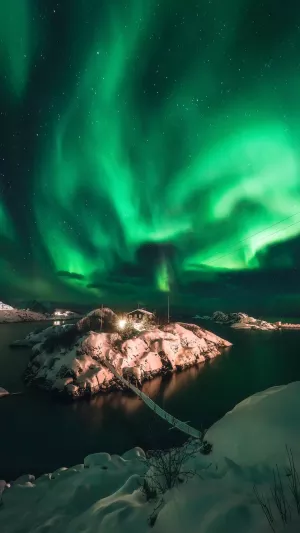Aurora is work performed by the sun and the earth's magnetic field. Among the many energy created by the sun, one energy is called "solar wind". The solar wind is a charged particle sprayed by the sun. This is a strong charged particle flow that can cover the earth.
The solar wind flows around the earth, hitting the earth's magnetic field at a speed of about 400 kilometers per second. The tip of the earth's magnetic field faces the two magnetic poles of the earth, and the charged particles emitted by the sun settle along the ground magnetic field and enter the pole areas of the earth.
Auroras are formed when the upper atmosphere at the poles is bombarded by solar winds and emits light.
When the oxygen atom collides with the high-energy electrons from the sun, it will absorb some energy, and the electron will begin to transition. Due to a large number of electrons of oxygen atoms, different electrostatic radiation generated by differently charged particles is different.
Oxygen atoms can radiate green light at 0.75s, but it takes 2min to radiate red light. Nitrogen radiation generally produces blue or purple light. Therefore, at the top of the atmosphere with a high oxygen content, there is sufficient time to leave the electronic leap, so it is easier to release the red light.
When the atmosphere is lower, the frequency of the collision becomes more frequent, and it does not have much time to react to the oxygen atom, so it is more likely to emit green light. Therefore, the red aurora will be covered by the green aurora, and we can only see the green aurora every day.
Due to the role of magnetic fields, these high-energy particles are turned to polar areas, so Aurora is common in high magnetic latitude areas. Aurora often appears in the range of about 25 ° to 30 ° from the magnetic pole. This area is called the Aurora area. The region between 45° and 60° latitude is called the weak auroral zone, and the region below 45° latitude is called the microauroral zone.
The main components of the earth's atmosphere are oxygen, nitrogen, and some rare gases. After the oxygen is excited, green and red light is emitted, and nitrogen emits purple, blue, and some dark red light. These colorful colors form a beautiful and spectacular aurora light.
Therefore, the more severe the solar wind, the more spectacular the aurora generated. Various stimulated atoms, molecules, and ions, and their complex compositions of the outer layer determine a variety of aurora changes.
Everyone said that in the life of a person's life, you must watch the aurora once. But when you think of the harsh environment in the polar, it will inevitably make people timid. But in fact, Aurora does not necessarily only exist in the polar, and the northern lights can be seen in the following places.
Alaska
Alaska is one of the best places for viewing the aurora on the planet. Here, the cold weather, the clear sky, and the dark night provided conditions for the best aurora. In Alaska, the best place to appreciate Aurora is Denley National Park. The natural park is around the highest peak of the American continent. Because of the isolation from the residential area, there is almost no light pollution.
Greenland
Greenland is the largest island on the planet, but it is also the country with the least population. The northern lights can be seen all year round, but the aurora that appears from August to October is particularly strong. During this time, most of the Aurora area occupied most of Greenland.
Sweden
Sweden is the largest country in Scandinavia, but the local population is very small. Most of its territory is covered by forests. From mid -September to the end of March, the best place to appreciate is Abasku in Lapland, Sweden. Due to the decorative effect of the dark night and the nearby lakes, this aurora is unimaginable.





